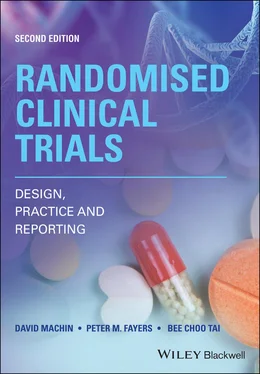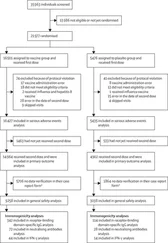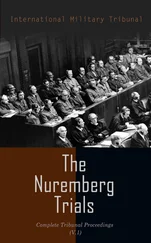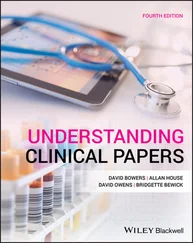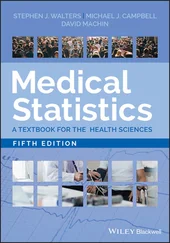Example 3.21 Protocol SQOLP01 (1999): Comparison of steroid with cyclosporine for the topical treatment of oral lichen planus
Analysis plan
Primary endpoints
Analysis of the primary endpoints of response and pain at 4 weeks will be made on an intention‐to‐treat basis.
Clinical response at 4 weeks
Comparison of the observed clinical response rates in the two treatment groups will be made using the χ 2‐test for the comparison of two proportions and a 95% confidence interval for the difference reported. In addition, logistic regression analysis will verify if this comparison requires adjustment for imbalance in the baseline clinical assessment values.
Comparison of means in the two treatment groups will be made using the t ‐test with the appropriate degrees of freedom and a 95% confidence interval for the difference reported. (Should the VAS scores not follow an approximate Normal distribution shape then this analysis may be replaced by the Wilcoxon test). In addition, regression analysis will verify if this comparison requires adjustment for imbalance in the baseline VAS values and clinical assessment values.
In those patients for which the marker lesion is measurable by the grid, the mean of the total area remaining affected at 4 weeks for each treatment group will be compared using the t ‐test and 95% confidence interval for the difference reported. In addition, regression analysis will verify if this comparison requires adjustment for imbalance in the baseline target lesion area values as well as its location and other clinical assessment values.
A more detailed longitudinal analysis will make use of all the individual measures (maximum 8 per patient) using the area under the curve (AUC) as the summary statistic for each patient. The mean AUC over all patients within the treatment group is calculated and then between treatment comparisons made using the t ‐test. A full statistical modelling approach using generalised estimating equations (GEE) is also anticipated. However, details of this latter methodology may have to await examination of the final data available. For example, this methodology would not be appropriate if all patients achieved complete response by week 4 and all subsequent target areas were then zero.
In similar ways, the complete VAS for burning sensation profile will be summarised.
It is not anticipated that a formal statistical analysis comparing the adverse event rates between groups will be conducted. However, full details will be presented and their presence (if any) used to contextualise any observed treatment differences.
Clinical response at week 8 will also be associated with initial (week 4) response to give an indication of the duration of response and to report any recurrences.
This example details a number of analyses. Some of the repetition could be reduced by replacing ‘adjustment for imbalance in the baseline’ by ‘adjustment for baseline’. Although this is very trivial example, if the number of words can be reduced without loss of clarity, then this reduces the eventual size of the document, facilitates the proof reading, and eases the job of the approving authorities.
As part of the monitoring of the progress of trials, while recruitment is still ongoing, many protocols include interim looks at the trial data and these may be reviewed by an independent Data and Safety Monitoring Board (DSMB) more details of which are given in Chapter 10. One example of the remit given to a DSMB is in Example 3.22, which is taken from the EXPEL (2016) protocol as described by Kim, Chen, Tay, et al . (2017).
Example 3.22Protocol EXPEL (2016): Peritoneal lavage after curative gastrectomy
An independent data monitoring committee (DMC) has been formed to monitor data and safety as this is a large clinical trial with multiple study sites. The DMC consists of subject matter experts who are not part of the EXPEL study team. An interim analysis will be performed after at least 200 subjects have completed 6‐months follow‐up. The purpose of the interim analysis is two-fold: firstly, to mitigate the risks from this trial should any unexpected serious adverse effects surface. Secondly, to allow for preliminary analysis of data to assess the efficacy of EIPL as compared with standard therapy. This would allow early closure of the trial should the efficacy be unequivocally proven, or modification of the trial with regard to increasing the sample size should it be deemed inadequate to show a more modest improvement in OS.
There are both general and specific issues that should be addressed in this section. These may range from ensuring that the protocol conforms to the internationally agreed Helsinki agreement and more recent Good Clinical Practice (GCP) regulations that have been adopted by many countries, through to obtaining local approval of the informed consent processes being applied.
There are internationally agreed standards under which clinical trials are conducted and these are encapsulated in GCP which is referenced as ICH E6 (R2) (2016). Then there are the more specific requirements, perhaps national as well as local, that must be adhered to. The precise details of these will vary with the trials’ geographical location, whether single or multicentre in design; local, national or international; the type of interventions under study, and the intended target participation groups.
Example 3.23 Protocol PRESSURE (2000): Pressure‐relieving support surfaces: a randomised evaluation
The study will be conducted in accordance with the Declaration of Helsinki in its latest form. The study will be submitted to and approved by a Regional Multicentre Research Ethics Committee (MREC) and the local Research Ethics Committee (LREC) of each participating centre prior to entering patients into the study. The NYCTRU will provide the LREC with a copy of the final protocol, patient information sheets and consent forms.
The conduct of the trial will be monitored by a Trial Steering Committee consisting of an independent Chair and two independent advisors as well as the project team (Appendix H).
Note this statement acknowledges that the trial development team are aware of potential updates of the Declaration of Helsinki. This will also be the case for any of the regulatory and other codes of practice that may pertain, as these too are continually being revised to meet new circumstances. However, if regulatory changes are made, they may or may not be invoked for ongoing protocols that have current approval status.
A major ethical requirement is to ensure that the potential participants in trials understand that participation is voluntary, and that they are free to withdraw their consent at any time and that doing so will not in any way compromise the future treatment that they will receive.
Example 3.24 Protocol SQGL02 (1999): Brimonidine as a neuroprotective agent in acute angle‐closure glaucoma
The right of the patient to refuse to participate without giving reasons must be respected. After the patient has entered the trial the clinician must remain free to give alternative treatment to that specified in the protocol at any stage if he/she feels it to be in the patient’s best interest. However, the reasons for doing so should be recorded and the patient will undergo an early termination visit for the purpose of follow‐up and data analysis. Similarly, the patient must remain free to withdraw at any time from protocol treatment without giving reasons and without prejudicing his/her further treatment.
Читать дальше
